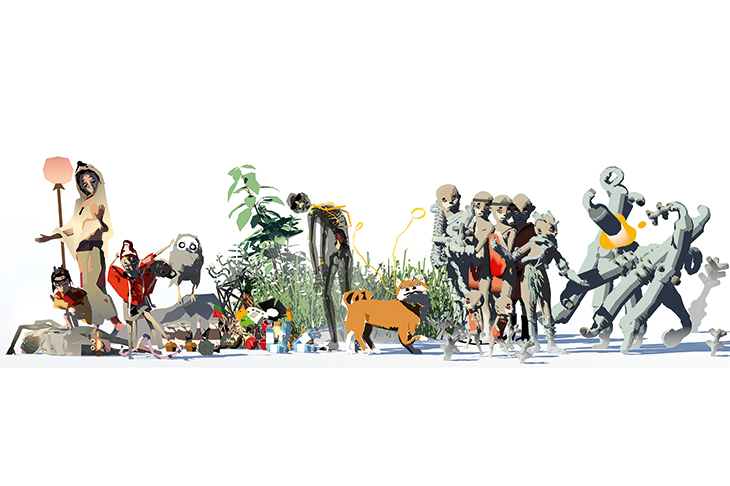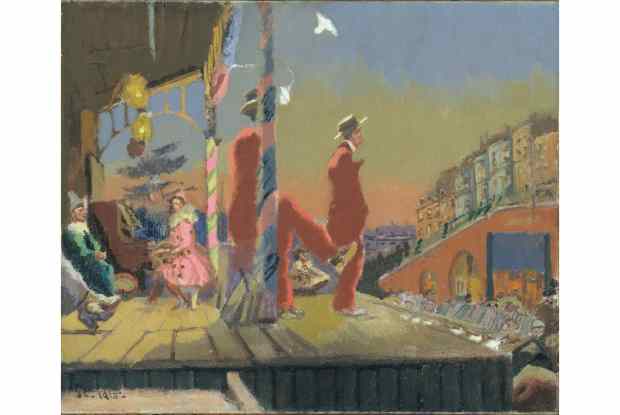Digital art is a crowded field. It’s also now older than I am. Yet despite a 50-year courtship, art galleries have been reluctant to allow it more than a toehold in their collections. Things are changing. Take MoMA’s visit to Paris last year. Alongside the Picassos and Pollocks was a very popular final room, made up of a single, beautiful computer-generated animation, in which a huddle of humans tramp across a constantly disintegrating landscape. ‘Emissaries’ (2015–17) is the work of the 33-year-old artist Ian Cheng, who two weeks ago opened his first show in the UK at the Serpentine Gallery.
Cheng’s first inspirations were video games like The Sims, and working in special effects on Pirates of the Caribbean. ‘They were trying to simulate a whirlpool that was like several kilometres wide, and they were trying to simulate it water particle for water particle… It was just like mind-boggling — just that they attempt to do that was very beautiful.’
Noticing that a number of his colleagues had artistic ambitions of their own — but had been working on the same short film since Return of the Jedi — Cheng packed in his production job to pursue a career as a fine artist, and made simulation his thing.
He started out being interested in rendering, in the idea of making something material-seeming in a digital space. ‘Brats’ (2012) saw a motion-capture Elmer Fudd chasing a motion-capture Bugs Bunny around a digital nowhere; ‘This Papaya Tastes Perfect’ (2011) was the weirdly ethereal simulation of a New York road-rage incident.
But his interest gradually shifted from the surfaces to the depths: not to the rendering of digital objects but the generative algorithms that could determine their behaviour. His last major work was ‘Emissaries’, a virtual world in which, having set things running, the artist would play the deus absconditus and stand back to see what happened. Answer: everyone started fighting and a lot of stuff caught fire. Cheng shrugs cheerfully: ‘Heh, yes. A very uncontrollable environment.’ The Serpentine will screen ‘Emissaries’ in the gallery from 24 April.
First up, though, is BOB, the latest development of his digital art. BOB stands for ‘Bag of Beliefs’. Having created a digital ecosystem of sorts in ‘Emissaries’, Cheng wanted to ‘focus on just one agent’: a single isolated character — in a sense, an internal ecosystem ‘tremendously more complex than “Emissaries”’. And that’s BOB.
It’s basically (as Cheng acknowledges) a sort of next-generation Tamagotchi: an artificial intelligence life form, living in an imaginary space, that looks like the result of a messy accident in an orange twig factory.
Two screens — one for each BOB — greet the viewer at the Serpentine Gallery (the main gallery space, behind them, is filled with the computers that run BOB) and show a pair of white spaces, each given the suggestion of depth by a single steepled window high on the right-hand side of the frame.
Beneath this window, BOB bobs; or, if you like, BOBs bob, since there are two of them and each is different. Each BOB starts out as a little orange ‘stub’ with a wee face on it, and over time will grow and wiggle about — sometimes becoming like a large bush; sometimes like a jointed worm gone wrong. Greyish dead bits of BOB, disconcertingly, cling to him or litter the digital floor where he has pruned himself. BOB gets fed twice a day (‘the gallery assistants push a button, basically’), learns from his experiences, such as they are, at the rate of 300MB a day, and you can interact with him through an iPhone X. Wiggle the phone about, and BOB’s limb, or branch, or whatever it is, wiggles with you. BOB doesn’t always like that. One recent visitor says that BOB tried to bite him.
The hope was originally to have BOB speaking unto BOB. Anyway they ran out of time, so that’s for the next show. As are further ambitions — embedding a BOB in the blockchain so he could make financial transactions; creating BOBs who could breed and inherit memories (Cheng seems to be a bit of a Lamarckian); or selling seed BOBs, like computer games, for users to grow their own.
The gallery’s bumf makes rather bold claims about BOB: that when he sees your face he may think you’re a hallucination; that he has feelings and thoughts. Can this be true?
‘The thing we really tried to model within BOB was how… basically, how BOB feels, and to think about feeling not as a discrete label, like an emotion, like sad, happy, angry, annoyed, but rather feeling as an N-dimensional space of measuring many many different criteria at many different moments.’
Like Cheng though I do — he has an ingenuous enthusiasm, and talks more like Bill and Ted (‘like totally’; ‘super-surprising’) than most fine artists — I have a strong hunch that philosophers of mind or AI experts would see this as complete bunkum. BOB, at least as Cheng explains him, is an input/output machine: a complex one, a probabilistic one, one with the ability to remember things and behave according to an associative rather than directly causal logic, sure. But that’s a long way from having feelings or a theory of mind or anything like a consciousness. If BOB was capable of ‘thinking’ ‘he’ was ‘hallucinating’ (I distribute these inverted commas freely but without complete confidence), BOB would not only be acing Turing tests, he’d probably already be plotting the assassination of John Connor.
Still, I’m not sure that matters all that much. What we project on to the work, and the work’s attempt to live up to that, is where the art happens. As Cheng says, the name for each BOB ‘is completely random on birth. It’s kind of like when a hospital names orphans. But the names afford a sort of projection — they’re for us, really. Like when someone names their Chihuahua ‘Little Thomas’ or ‘Little Sophie’ or something? The Chihuahua doesn’t know and it might not even match its personality. Thomas might be totally the wrong name for that particular Chihuahua!’
And when I ask him about how he chooses the starting conditions for these self-generating simulations, he says: ‘Super-stupid criteria: it’s something I have to fall in love with. It’s super-dumb. Like how the basic Bob face looks, and what colour he starts out… so I could love him. Or love it. I just really wanted to love this creature. I have to love what I’m working on because otherwise it gets super-depressing halfway in and I might not finish.’
For a loving father, then, the behaviour of one trial BOB was disconcerting. ‘The first time we were testing a full-grown BOB — he was a serpent-/tree-like structure — and he just got into this fit, and just completely pruned for like 50 minutes, every little bit, almost like when you meet someone who’s missing an eyebrow, and they had this fit last night and picked out every hair. That one just chomped himself down to a stub and then he was just a stub for like a day or something.’
He reflects: ‘This was like super-surprising? Kind of sad but also very beautiful in a way.’
Got something to add? Join the discussion and comment below.
Get 10 issues for just $10
Subscribe to The Spectator Australia today for the next 10 magazine issues, plus full online access, for just $10.
You might disagree with half of it, but you’ll enjoy reading all of it. Try your first month for free, then just $2 a week for the remainder of your first year.















Comments
Don't miss out
Join the conversation with other Spectator Australia readers. Subscribe to leave a comment.
SUBSCRIBEAlready a subscriber? Log in